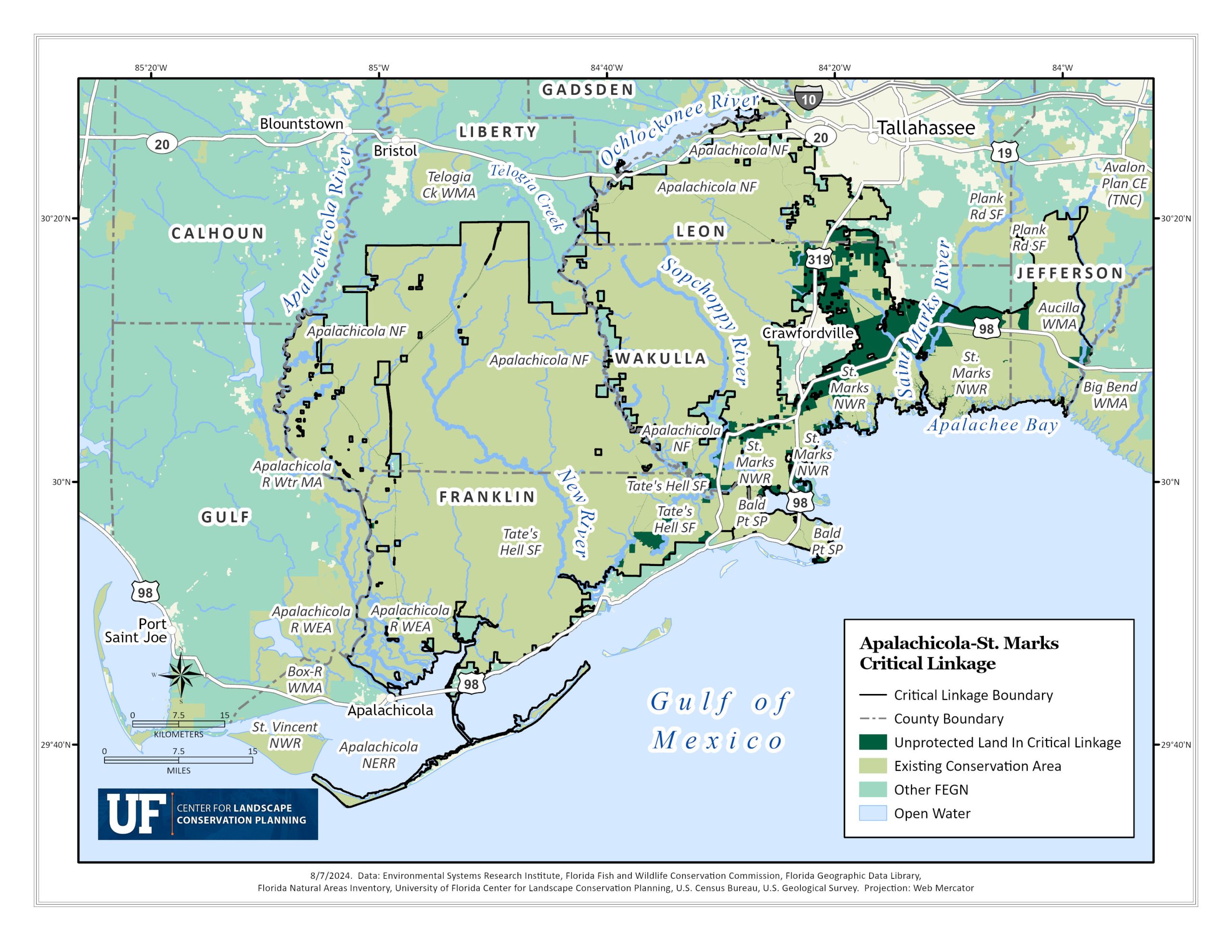The Apalachicola – St. Marks Critical Linkage
In the narrow bend between Florida’s panhandle and the rest of the peninsula, Florida’s state capital was founded in 1824 at the then small town of Tallahassee. Now a major city home to over 200,000 residents, Tallahassee’s footprint continues to grow.
The effects of population growth and sprawl from Tallahassee is one of the most critical threats to the Apalachicola-St. Marks Critical Linkage. A 30-minute car ride, or about a 20 mile drive down FL-393, can bring you from the heart of the capital city to the small town of St. Marks, where the Wakulla and St. Marks River’s converge before flowing to Apalachee Bay and the greater Gulf of Mexico. A successful Apalachicola-St. Marks linkage would include an unfragmented connection between Apalachicola National Forest just south of Tallahassee, Wakulla Springs Management Area, and a linkage following the Wakulla River to the protected coastal lands along Apalachee Bay.

From springs to sinks, blackwater streams, and winding creeks to marshland and wetlands, this small linkage is comprised of a diversity of natural hydrologic features unique to the state. One of the most prized hydrological features is Wakulla Springs. One of Florida’s largest and deepest first magnitude springs, Wakulla is visited by over 200,000 people each year, about the same number of people living 14 miles north in the state capital. The spring forms the Wakulla River, which feeds Apalachee Bay another 14 miles to the south. A lesser-known spring system, the Spring Creek Springs or Spring Creek Rise, are “Submarine Springs” hidden in the marine estuaries of Oyster Bay. The Spring Creek Rise and Wakulla are interconnected through groundwater flow cycling. There are significant threats to spring systems in the region, including saltwater intrusion from groundwater pumping and nitrate pollution from wastewater in the springhead. Land conservation in this linkage would aid in the protection of high priority aquifer recharge and surface water resource priority areas within and surrounding the Wakulla Springs Watershed. This would not only benefit the ecological integrity of the linkage but would also provide benefits the human communities in the area who depend on the aquifer recharge and healthy springs for clean water, nature-based recreation and other ecosystem services provided.
Bear mortalities along key road corridors in this region are a major challenge for conservationists. Despite the high number of mortalities, the region is incredibly important for black bear population health. The Apalachicola-St. Marks Critical Linkage is the essential connector between peninsular and panhandle Black Bear populations. The more land preserved within the critical linkage, the less the linkage is narrowed or fragmented, allowing more space for large mammals like the Florida Black Bear to traverse the Florida landscape. Other benefits for bears in this linkage would be the introduction of new wildlife crossings across major roadways. The linkage also overlaps with potential reintroduction areas for the Florida Panther; the Apalachicola National Forest and adjacent lands as well as the Big Bend and NW Peninsula focus areas stand out as the largest areas with quality habitat that could support panther populations. This linkage could help connect these two areas, if the opportunities for recovery were acted upon.

Unprotected Land Cover Map for the Apalachicola-St. Marks Linkage
The future of the linkage is dependent on the protection of currently unprotected land within this FEGN / Florida Wildlife Corridor priority one region. This map provides a breakdown of the types of unprotected land cover in the Apalachicola-St.Marks linkage.

